Managerial Accounting: Executive Performance Evaluation at RWC
VerifiedAdded on 2023/06/07
|23
|4723
|88
Report
AI Summary
This report explores financial and non-financial measures for executive remuneration, comparing Reliance Worldwide and ALS Limited's remuneration policies. It examines performance measurement systems, the impact of financial and non-financial measures on organizational objectives, and the effectiveness of different evaluation methods. The report reviews literature on performance-based management systems, management by objectives (MBO), balanced scorecards, and results-based leadership, highlighting key performance indicators and incentive plans. It also provides an analysis of the remuneration structures, including fixed remuneration, short-term incentives (STI), and long-term incentives (LTI), and concludes with a comparison of the remuneration methods used by the two companies.

Running head: MANAGERAL ACCOUNTING
Managerial Accounting
Name of the Student
Name of the University
Author Note
Managerial Accounting
Name of the Student
Name of the University
Author Note
Paraphrase This Document
Need a fresh take? Get an instant paraphrase of this document with our AI Paraphraser
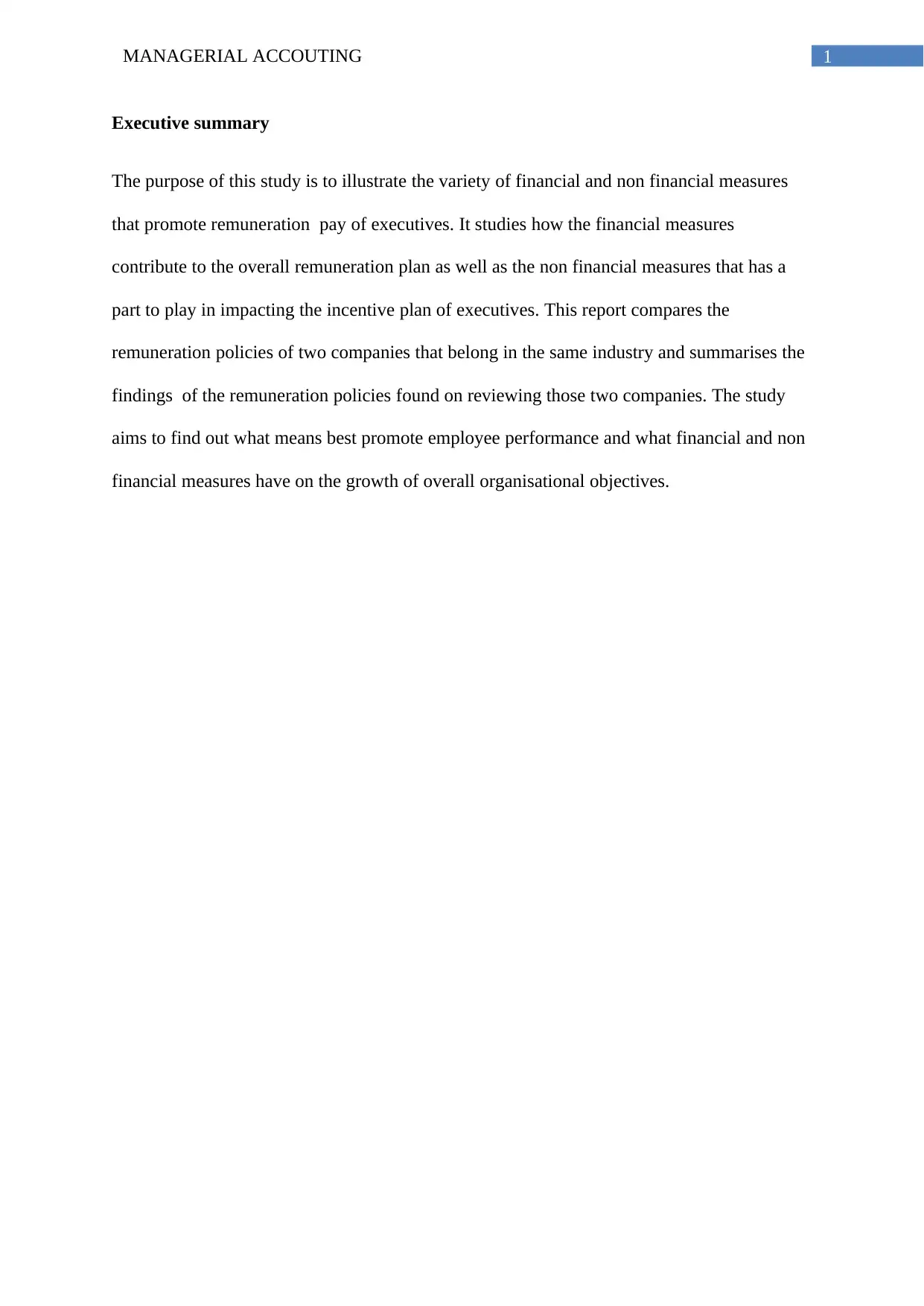
1MANAGERIAL ACCOUTING
Executive summary
The purpose of this study is to illustrate the variety of financial and non financial measures
that promote remuneration pay of executives. It studies how the financial measures
contribute to the overall remuneration plan as well as the non financial measures that has a
part to play in impacting the incentive plan of executives. This report compares the
remuneration policies of two companies that belong in the same industry and summarises the
findings of the remuneration policies found on reviewing those two companies. The study
aims to find out what means best promote employee performance and what financial and non
financial measures have on the growth of overall organisational objectives.
Executive summary
The purpose of this study is to illustrate the variety of financial and non financial measures
that promote remuneration pay of executives. It studies how the financial measures
contribute to the overall remuneration plan as well as the non financial measures that has a
part to play in impacting the incentive plan of executives. This report compares the
remuneration policies of two companies that belong in the same industry and summarises the
findings of the remuneration policies found on reviewing those two companies. The study
aims to find out what means best promote employee performance and what financial and non
financial measures have on the growth of overall organisational objectives.
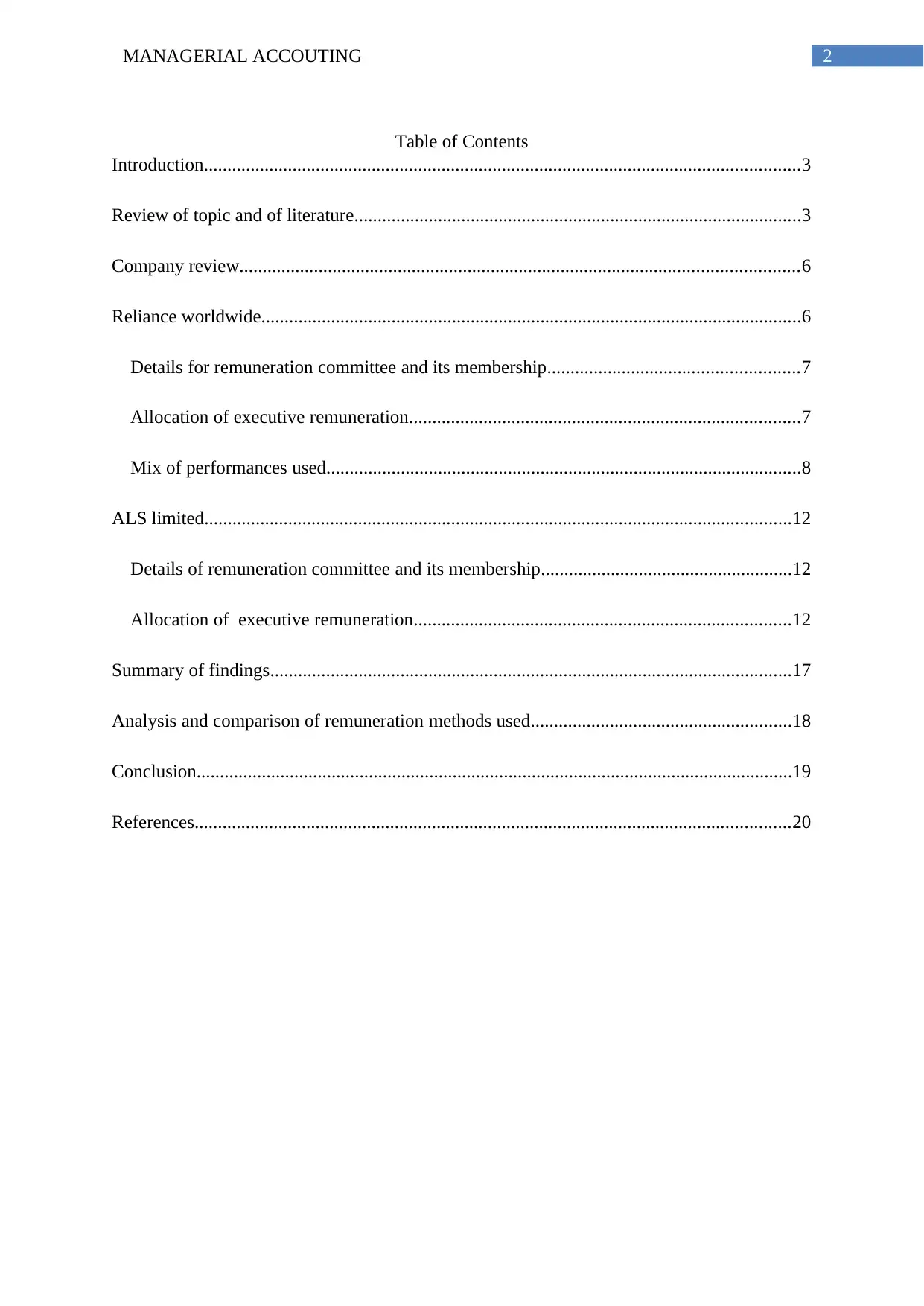
2MANAGERIAL ACCOUTING
Table of Contents
Introduction................................................................................................................................3
Review of topic and of literature................................................................................................3
Company review........................................................................................................................6
Reliance worldwide....................................................................................................................6
Details for remuneration committee and its membership......................................................7
Allocation of executive remuneration....................................................................................7
Mix of performances used......................................................................................................8
ALS limited..............................................................................................................................12
Details of remuneration committee and its membership......................................................12
Allocation of executive remuneration.................................................................................12
Summary of findings................................................................................................................17
Analysis and comparison of remuneration methods used........................................................18
Conclusion................................................................................................................................19
References................................................................................................................................20
Table of Contents
Introduction................................................................................................................................3
Review of topic and of literature................................................................................................3
Company review........................................................................................................................6
Reliance worldwide....................................................................................................................6
Details for remuneration committee and its membership......................................................7
Allocation of executive remuneration....................................................................................7
Mix of performances used......................................................................................................8
ALS limited..............................................................................................................................12
Details of remuneration committee and its membership......................................................12
Allocation of executive remuneration.................................................................................12
Summary of findings................................................................................................................17
Analysis and comparison of remuneration methods used........................................................18
Conclusion................................................................................................................................19
References................................................................................................................................20
⊘ This is a preview!⊘
Do you want full access?
Subscribe today to unlock all pages.

Trusted by 1+ million students worldwide
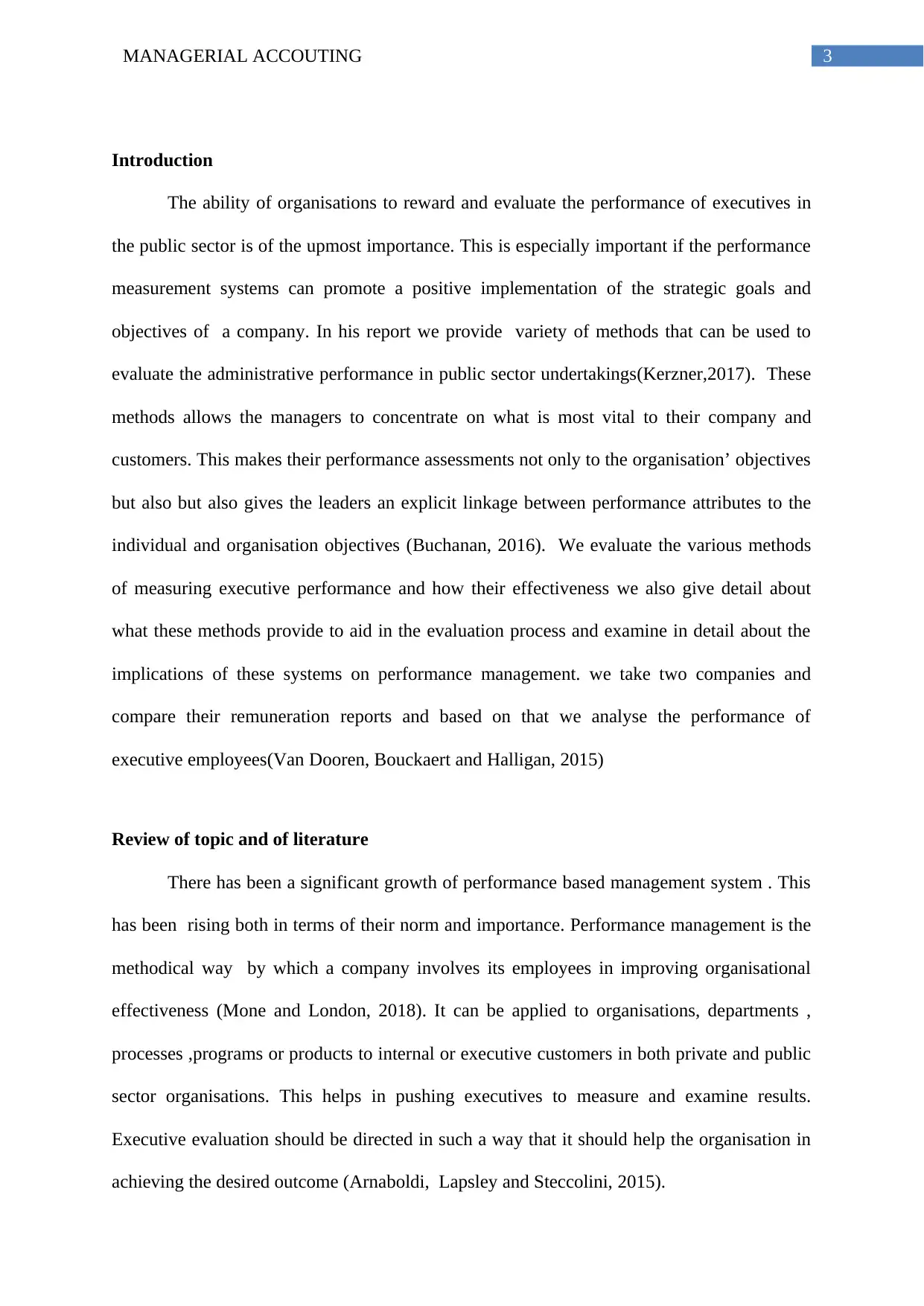
3MANAGERIAL ACCOUTING
Introduction
The ability of organisations to reward and evaluate the performance of executives in
the public sector is of the upmost importance. This is especially important if the performance
measurement systems can promote a positive implementation of the strategic goals and
objectives of a company. In his report we provide variety of methods that can be used to
evaluate the administrative performance in public sector undertakings(Kerzner,2017). These
methods allows the managers to concentrate on what is most vital to their company and
customers. This makes their performance assessments not only to the organisation’ objectives
but also but also gives the leaders an explicit linkage between performance attributes to the
individual and organisation objectives (Buchanan, 2016). We evaluate the various methods
of measuring executive performance and how their effectiveness we also give detail about
what these methods provide to aid in the evaluation process and examine in detail about the
implications of these systems on performance management. we take two companies and
compare their remuneration reports and based on that we analyse the performance of
executive employees(Van Dooren, Bouckaert and Halligan, 2015)
Review of topic and of literature
There has been a significant growth of performance based management system . This
has been rising both in terms of their norm and importance. Performance management is the
methodical way by which a company involves its employees in improving organisational
effectiveness (Mone and London, 2018). It can be applied to organisations, departments ,
processes ,programs or products to internal or executive customers in both private and public
sector organisations. This helps in pushing executives to measure and examine results.
Executive evaluation should be directed in such a way that it should help the organisation in
achieving the desired outcome (Arnaboldi, Lapsley and Steccolini, 2015).
Introduction
The ability of organisations to reward and evaluate the performance of executives in
the public sector is of the upmost importance. This is especially important if the performance
measurement systems can promote a positive implementation of the strategic goals and
objectives of a company. In his report we provide variety of methods that can be used to
evaluate the administrative performance in public sector undertakings(Kerzner,2017). These
methods allows the managers to concentrate on what is most vital to their company and
customers. This makes their performance assessments not only to the organisation’ objectives
but also but also gives the leaders an explicit linkage between performance attributes to the
individual and organisation objectives (Buchanan, 2016). We evaluate the various methods
of measuring executive performance and how their effectiveness we also give detail about
what these methods provide to aid in the evaluation process and examine in detail about the
implications of these systems on performance management. we take two companies and
compare their remuneration reports and based on that we analyse the performance of
executive employees(Van Dooren, Bouckaert and Halligan, 2015)
Review of topic and of literature
There has been a significant growth of performance based management system . This
has been rising both in terms of their norm and importance. Performance management is the
methodical way by which a company involves its employees in improving organisational
effectiveness (Mone and London, 2018). It can be applied to organisations, departments ,
processes ,programs or products to internal or executive customers in both private and public
sector organisations. This helps in pushing executives to measure and examine results.
Executive evaluation should be directed in such a way that it should help the organisation in
achieving the desired outcome (Arnaboldi, Lapsley and Steccolini, 2015).
Paraphrase This Document
Need a fresh take? Get an instant paraphrase of this document with our AI Paraphraser
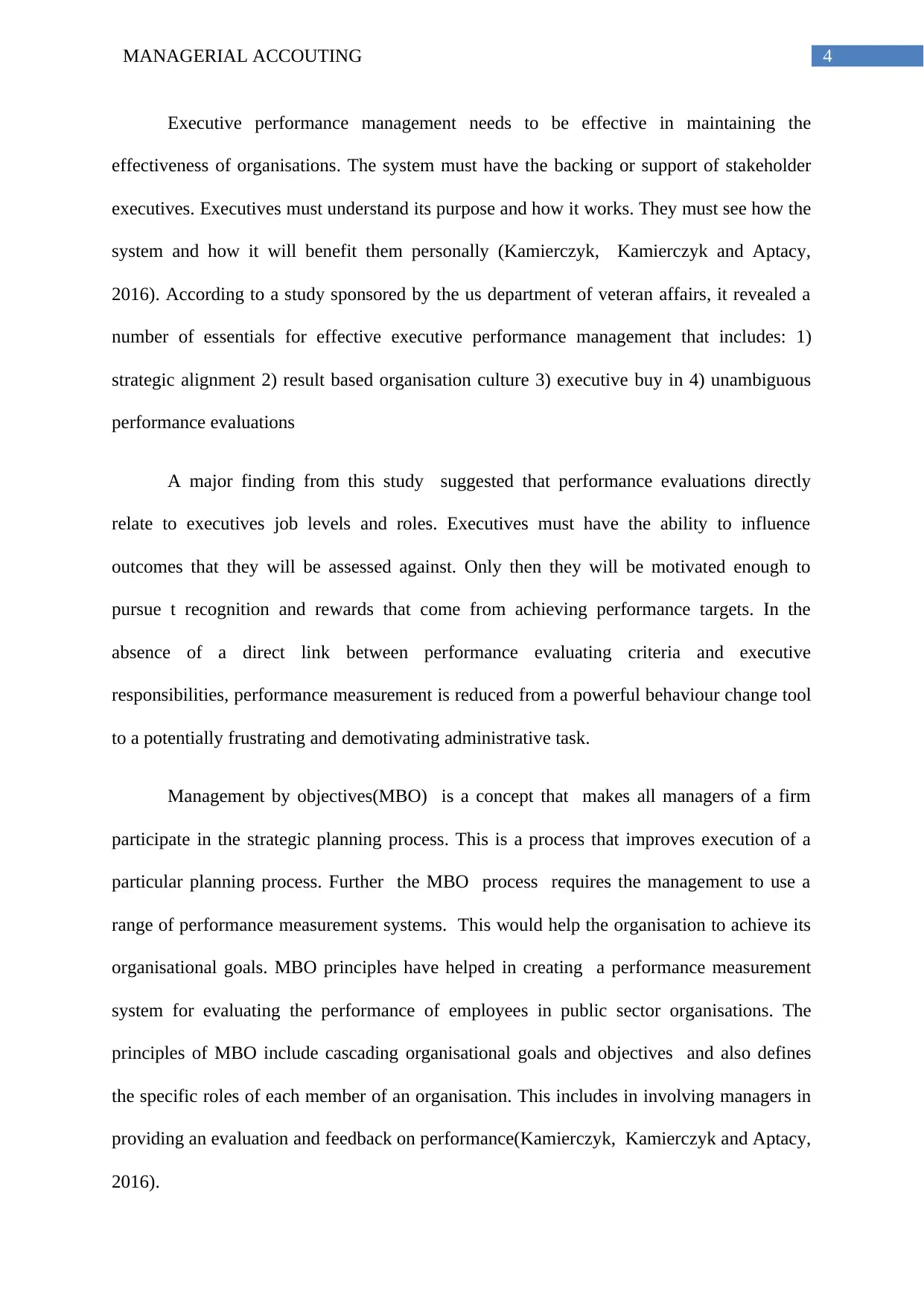
4MANAGERIAL ACCOUTING
Executive performance management needs to be effective in maintaining the
effectiveness of organisations. The system must have the backing or support of stakeholder
executives. Executives must understand its purpose and how it works. They must see how the
system and how it will benefit them personally (Kamierczyk, Kamierczyk and Aptacy,
2016). According to a study sponsored by the us department of veteran affairs, it revealed a
number of essentials for effective executive performance management that includes: 1)
strategic alignment 2) result based organisation culture 3) executive buy in 4) unambiguous
performance evaluations
A major finding from this study suggested that performance evaluations directly
relate to executives job levels and roles. Executives must have the ability to influence
outcomes that they will be assessed against. Only then they will be motivated enough to
pursue t recognition and rewards that come from achieving performance targets. In the
absence of a direct link between performance evaluating criteria and executive
responsibilities, performance measurement is reduced from a powerful behaviour change tool
to a potentially frustrating and demotivating administrative task.
Management by objectives(MBO) is a concept that makes all managers of a firm
participate in the strategic planning process. This is a process that improves execution of a
particular planning process. Further the MBO process requires the management to use a
range of performance measurement systems. This would help the organisation to achieve its
organisational goals. MBO principles have helped in creating a performance measurement
system for evaluating the performance of employees in public sector organisations. The
principles of MBO include cascading organisational goals and objectives and also defines
the specific roles of each member of an organisation. This includes in involving managers in
providing an evaluation and feedback on performance(Kamierczyk, Kamierczyk and Aptacy,
2016).
Executive performance management needs to be effective in maintaining the
effectiveness of organisations. The system must have the backing or support of stakeholder
executives. Executives must understand its purpose and how it works. They must see how the
system and how it will benefit them personally (Kamierczyk, Kamierczyk and Aptacy,
2016). According to a study sponsored by the us department of veteran affairs, it revealed a
number of essentials for effective executive performance management that includes: 1)
strategic alignment 2) result based organisation culture 3) executive buy in 4) unambiguous
performance evaluations
A major finding from this study suggested that performance evaluations directly
relate to executives job levels and roles. Executives must have the ability to influence
outcomes that they will be assessed against. Only then they will be motivated enough to
pursue t recognition and rewards that come from achieving performance targets. In the
absence of a direct link between performance evaluating criteria and executive
responsibilities, performance measurement is reduced from a powerful behaviour change tool
to a potentially frustrating and demotivating administrative task.
Management by objectives(MBO) is a concept that makes all managers of a firm
participate in the strategic planning process. This is a process that improves execution of a
particular planning process. Further the MBO process requires the management to use a
range of performance measurement systems. This would help the organisation to achieve its
organisational goals. MBO principles have helped in creating a performance measurement
system for evaluating the performance of employees in public sector organisations. The
principles of MBO include cascading organisational goals and objectives and also defines
the specific roles of each member of an organisation. This includes in involving managers in
providing an evaluation and feedback on performance(Kamierczyk, Kamierczyk and Aptacy,
2016).
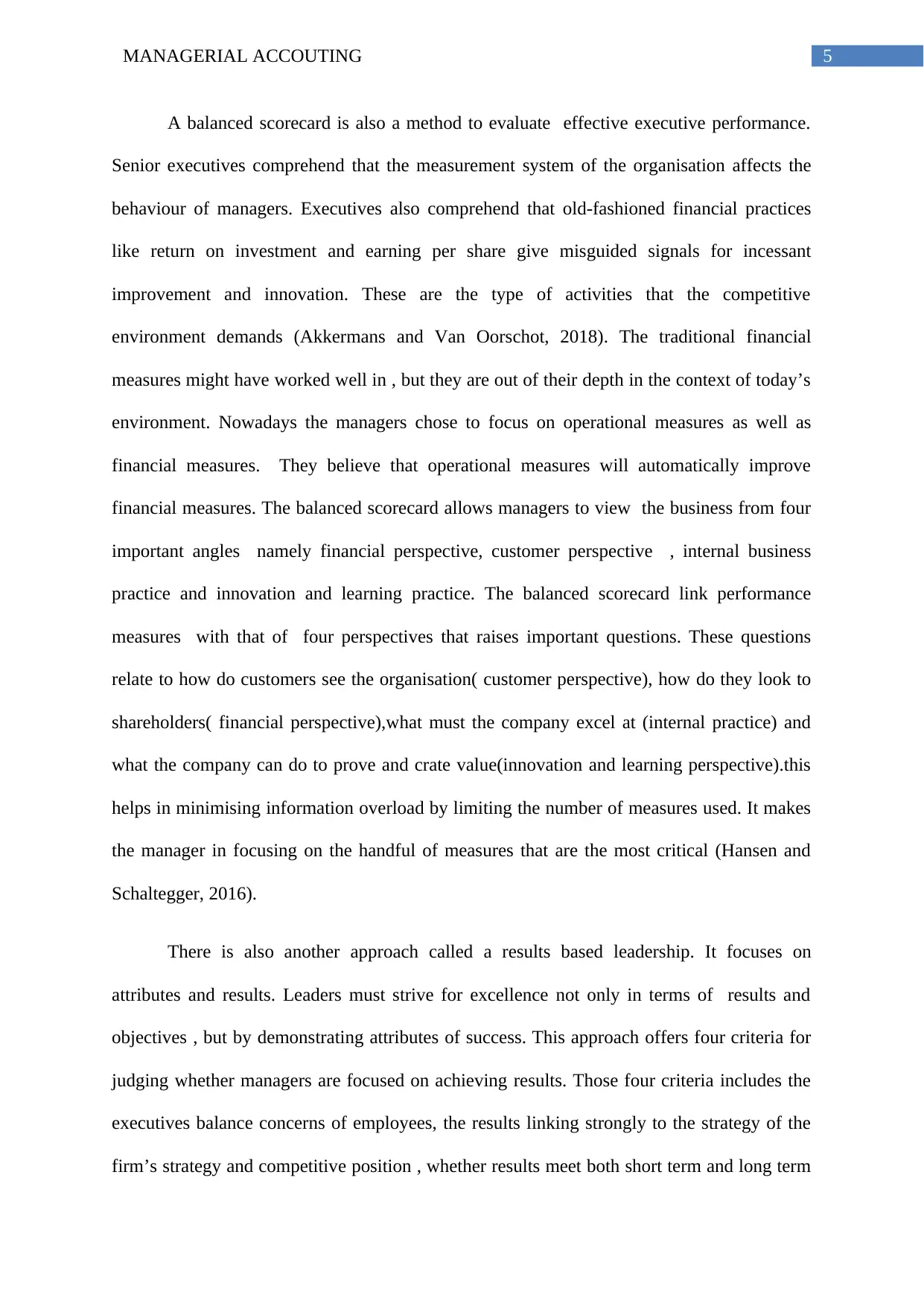
5MANAGERIAL ACCOUTING
A balanced scorecard is also a method to evaluate effective executive performance.
Senior executives comprehend that the measurement system of the organisation affects the
behaviour of managers. Executives also comprehend that old-fashioned financial practices
like return on investment and earning per share give misguided signals for incessant
improvement and innovation. These are the type of activities that the competitive
environment demands (Akkermans and Van Oorschot, 2018). The traditional financial
measures might have worked well in , but they are out of their depth in the context of today’s
environment. Nowadays the managers chose to focus on operational measures as well as
financial measures. They believe that operational measures will automatically improve
financial measures. The balanced scorecard allows managers to view the business from four
important angles namely financial perspective, customer perspective , internal business
practice and innovation and learning practice. The balanced scorecard link performance
measures with that of four perspectives that raises important questions. These questions
relate to how do customers see the organisation( customer perspective), how do they look to
shareholders( financial perspective),what must the company excel at (internal practice) and
what the company can do to prove and crate value(innovation and learning perspective).this
helps in minimising information overload by limiting the number of measures used. It makes
the manager in focusing on the handful of measures that are the most critical (Hansen and
Schaltegger, 2016).
There is also another approach called a results based leadership. It focuses on
attributes and results. Leaders must strive for excellence not only in terms of results and
objectives , but by demonstrating attributes of success. This approach offers four criteria for
judging whether managers are focused on achieving results. Those four criteria includes the
executives balance concerns of employees, the results linking strongly to the strategy of the
firm’s strategy and competitive position , whether results meet both short term and long term
A balanced scorecard is also a method to evaluate effective executive performance.
Senior executives comprehend that the measurement system of the organisation affects the
behaviour of managers. Executives also comprehend that old-fashioned financial practices
like return on investment and earning per share give misguided signals for incessant
improvement and innovation. These are the type of activities that the competitive
environment demands (Akkermans and Van Oorschot, 2018). The traditional financial
measures might have worked well in , but they are out of their depth in the context of today’s
environment. Nowadays the managers chose to focus on operational measures as well as
financial measures. They believe that operational measures will automatically improve
financial measures. The balanced scorecard allows managers to view the business from four
important angles namely financial perspective, customer perspective , internal business
practice and innovation and learning practice. The balanced scorecard link performance
measures with that of four perspectives that raises important questions. These questions
relate to how do customers see the organisation( customer perspective), how do they look to
shareholders( financial perspective),what must the company excel at (internal practice) and
what the company can do to prove and crate value(innovation and learning perspective).this
helps in minimising information overload by limiting the number of measures used. It makes
the manager in focusing on the handful of measures that are the most critical (Hansen and
Schaltegger, 2016).
There is also another approach called a results based leadership. It focuses on
attributes and results. Leaders must strive for excellence not only in terms of results and
objectives , but by demonstrating attributes of success. This approach offers four criteria for
judging whether managers are focused on achieving results. Those four criteria includes the
executives balance concerns of employees, the results linking strongly to the strategy of the
firm’s strategy and competitive position , whether results meet both short term and long term
⊘ This is a preview!⊘
Do you want full access?
Subscribe today to unlock all pages.

Trusted by 1+ million students worldwide
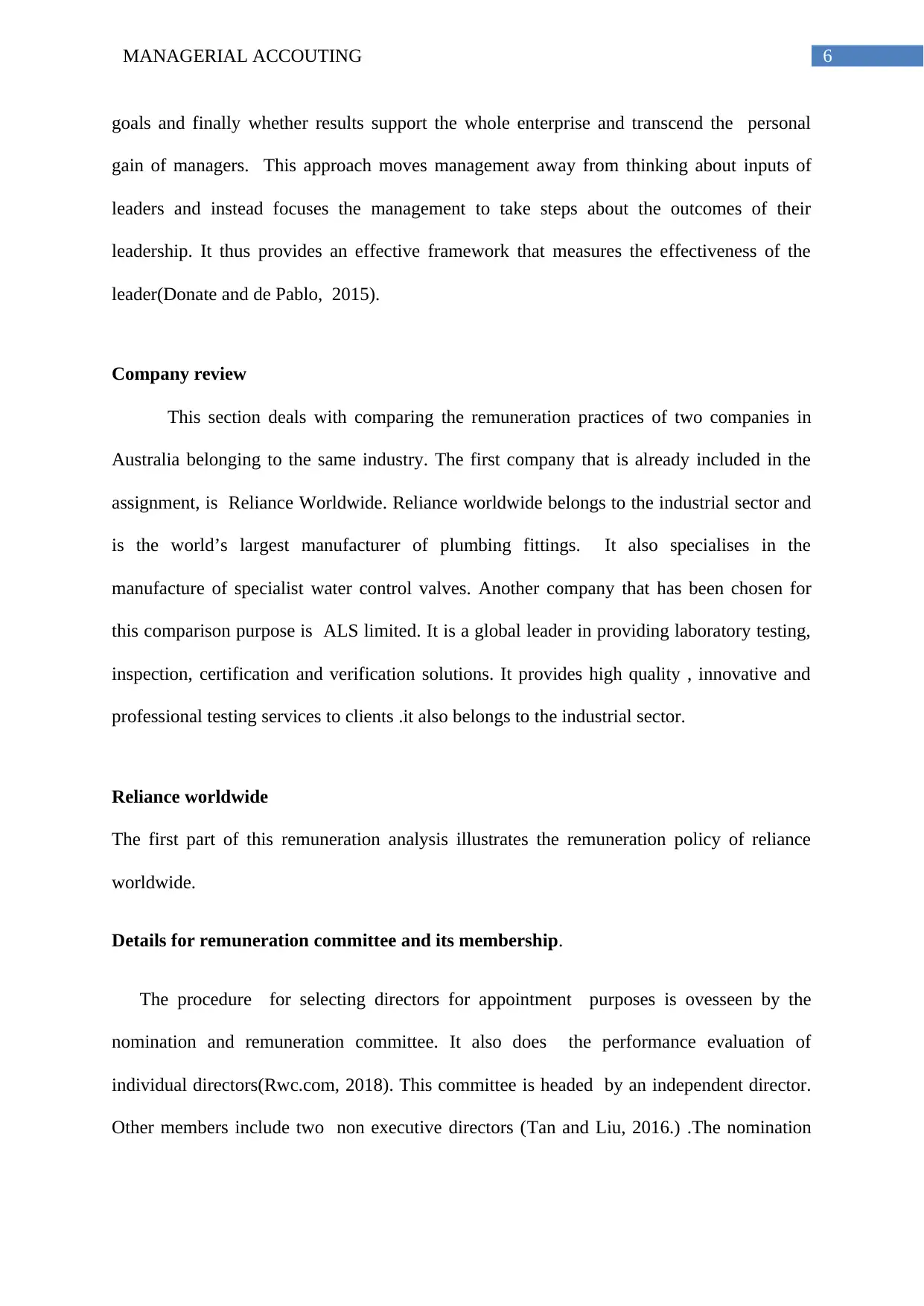
6MANAGERIAL ACCOUTING
goals and finally whether results support the whole enterprise and transcend the personal
gain of managers. This approach moves management away from thinking about inputs of
leaders and instead focuses the management to take steps about the outcomes of their
leadership. It thus provides an effective framework that measures the effectiveness of the
leader(Donate and de Pablo, 2015).
Company review
This section deals with comparing the remuneration practices of two companies in
Australia belonging to the same industry. The first company that is already included in the
assignment, is Reliance Worldwide. Reliance worldwide belongs to the industrial sector and
is the world’s largest manufacturer of plumbing fittings. It also specialises in the
manufacture of specialist water control valves. Another company that has been chosen for
this comparison purpose is ALS limited. It is a global leader in providing laboratory testing,
inspection, certification and verification solutions. It provides high quality , innovative and
professional testing services to clients .it also belongs to the industrial sector.
Reliance worldwide
The first part of this remuneration analysis illustrates the remuneration policy of reliance
worldwide.
Details for remuneration committee and its membership.
The procedure for selecting directors for appointment purposes is ovesseen by the
nomination and remuneration committee. It also does the performance evaluation of
individual directors(Rwc.com, 2018). This committee is headed by an independent director.
Other members include two non executive directors (Tan and Liu, 2016.) .The nomination
goals and finally whether results support the whole enterprise and transcend the personal
gain of managers. This approach moves management away from thinking about inputs of
leaders and instead focuses the management to take steps about the outcomes of their
leadership. It thus provides an effective framework that measures the effectiveness of the
leader(Donate and de Pablo, 2015).
Company review
This section deals with comparing the remuneration practices of two companies in
Australia belonging to the same industry. The first company that is already included in the
assignment, is Reliance Worldwide. Reliance worldwide belongs to the industrial sector and
is the world’s largest manufacturer of plumbing fittings. It also specialises in the
manufacture of specialist water control valves. Another company that has been chosen for
this comparison purpose is ALS limited. It is a global leader in providing laboratory testing,
inspection, certification and verification solutions. It provides high quality , innovative and
professional testing services to clients .it also belongs to the industrial sector.
Reliance worldwide
The first part of this remuneration analysis illustrates the remuneration policy of reliance
worldwide.
Details for remuneration committee and its membership.
The procedure for selecting directors for appointment purposes is ovesseen by the
nomination and remuneration committee. It also does the performance evaluation of
individual directors(Rwc.com, 2018). This committee is headed by an independent director.
Other members include two non executive directors (Tan and Liu, 2016.) .The nomination
Paraphrase This Document
Need a fresh take? Get an instant paraphrase of this document with our AI Paraphraser
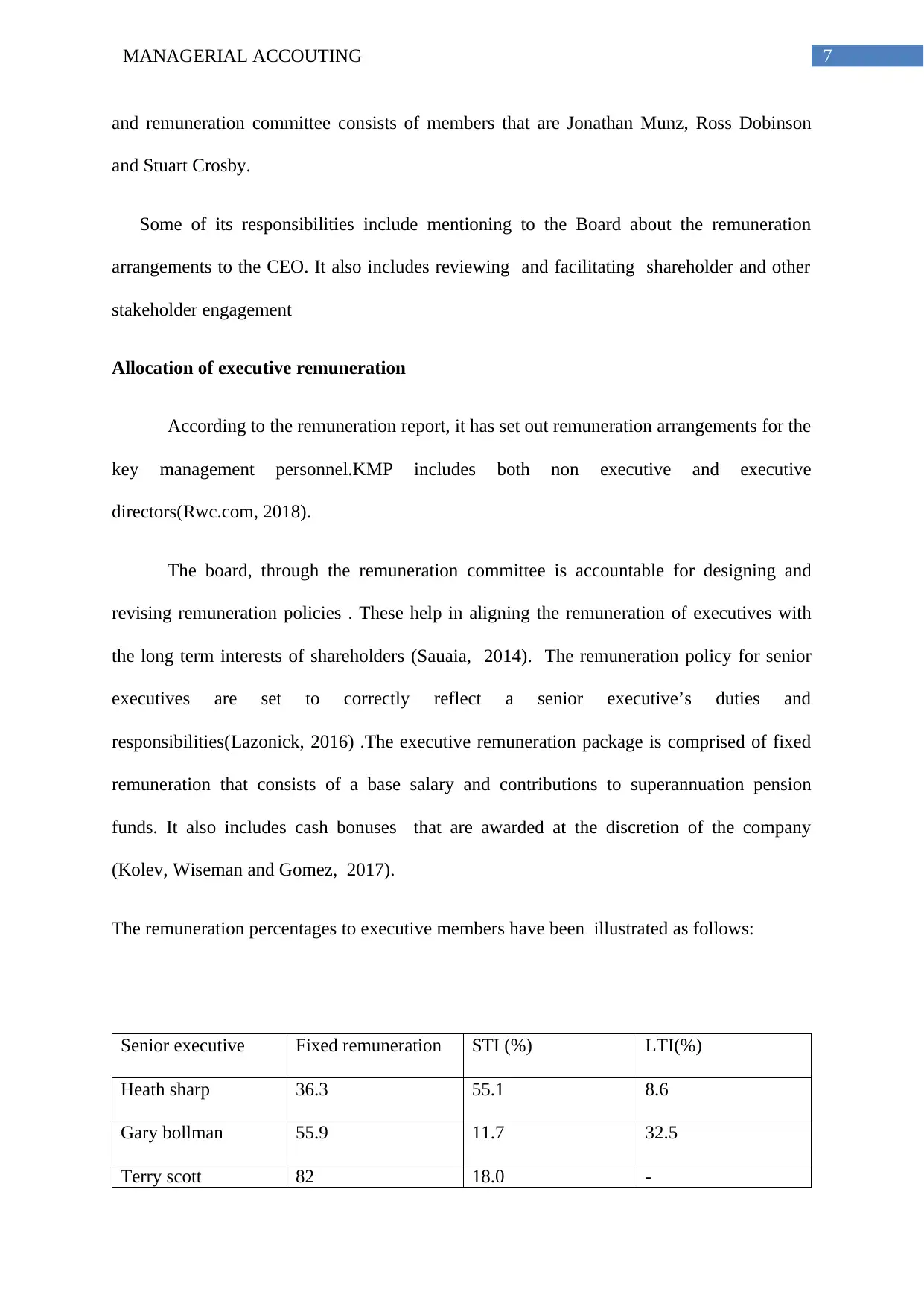
7MANAGERIAL ACCOUTING
and remuneration committee consists of members that are Jonathan Munz, Ross Dobinson
and Stuart Crosby.
Some of its responsibilities include mentioning to the Board about the remuneration
arrangements to the CEO. It also includes reviewing and facilitating shareholder and other
stakeholder engagement
Allocation of executive remuneration
According to the remuneration report, it has set out remuneration arrangements for the
key management personnel.KMP includes both non executive and executive
directors(Rwc.com, 2018).
The board, through the remuneration committee is accountable for designing and
revising remuneration policies . These help in aligning the remuneration of executives with
the long term interests of shareholders (Sauaia, 2014). The remuneration policy for senior
executives are set to correctly reflect a senior executive’s duties and
responsibilities(Lazonick, 2016) .The executive remuneration package is comprised of fixed
remuneration that consists of a base salary and contributions to superannuation pension
funds. It also includes cash bonuses that are awarded at the discretion of the company
(Kolev, Wiseman and Gomez, 2017).
The remuneration percentages to executive members have been illustrated as follows:
Senior executive Fixed remuneration STI (%) LTI(%)
Heath sharp 36.3 55.1 8.6
Gary bollman 55.9 11.7 32.5
Terry scott 82 18.0 -
and remuneration committee consists of members that are Jonathan Munz, Ross Dobinson
and Stuart Crosby.
Some of its responsibilities include mentioning to the Board about the remuneration
arrangements to the CEO. It also includes reviewing and facilitating shareholder and other
stakeholder engagement
Allocation of executive remuneration
According to the remuneration report, it has set out remuneration arrangements for the
key management personnel.KMP includes both non executive and executive
directors(Rwc.com, 2018).
The board, through the remuneration committee is accountable for designing and
revising remuneration policies . These help in aligning the remuneration of executives with
the long term interests of shareholders (Sauaia, 2014). The remuneration policy for senior
executives are set to correctly reflect a senior executive’s duties and
responsibilities(Lazonick, 2016) .The executive remuneration package is comprised of fixed
remuneration that consists of a base salary and contributions to superannuation pension
funds. It also includes cash bonuses that are awarded at the discretion of the company
(Kolev, Wiseman and Gomez, 2017).
The remuneration percentages to executive members have been illustrated as follows:
Senior executive Fixed remuneration STI (%) LTI(%)
Heath sharp 36.3 55.1 8.6
Gary bollman 55.9 11.7 32.5
Terry scott 82 18.0 -
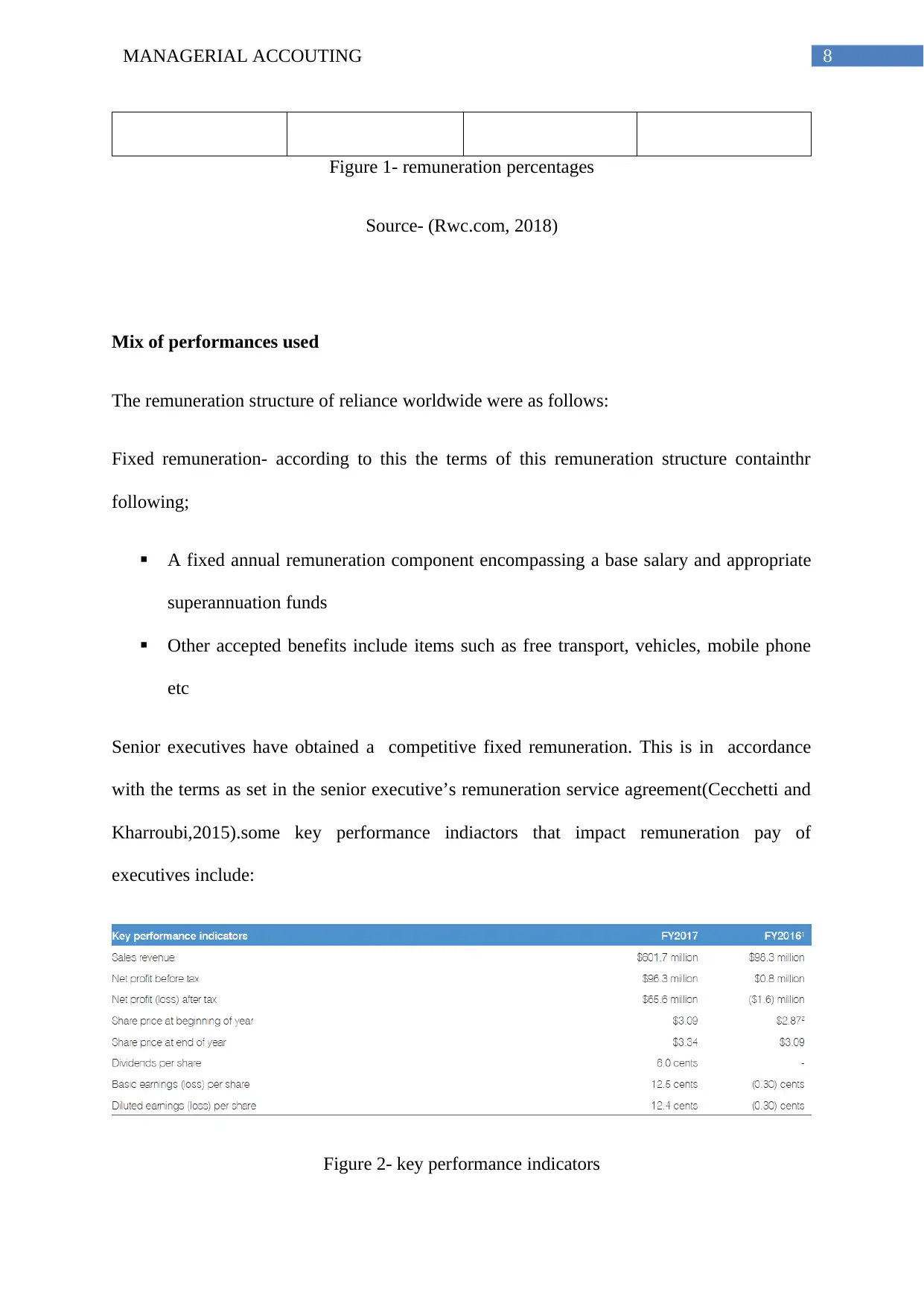
8MANAGERIAL ACCOUTING
Figure 1- remuneration percentages
Source- (Rwc.com, 2018)
Mix of performances used
The remuneration structure of reliance worldwide were as follows:
Fixed remuneration- according to this the terms of this remuneration structure containthr
following;
A fixed annual remuneration component encompassing a base salary and appropriate
superannuation funds
Other accepted benefits include items such as free transport, vehicles, mobile phone
etc
Senior executives have obtained a competitive fixed remuneration. This is in accordance
with the terms as set in the senior executive’s remuneration service agreement(Cecchetti and
Kharroubi,2015).some key performance indiactors that impact remuneration pay of
executives include:
Figure 2- key performance indicators
Figure 1- remuneration percentages
Source- (Rwc.com, 2018)
Mix of performances used
The remuneration structure of reliance worldwide were as follows:
Fixed remuneration- according to this the terms of this remuneration structure containthr
following;
A fixed annual remuneration component encompassing a base salary and appropriate
superannuation funds
Other accepted benefits include items such as free transport, vehicles, mobile phone
etc
Senior executives have obtained a competitive fixed remuneration. This is in accordance
with the terms as set in the senior executive’s remuneration service agreement(Cecchetti and
Kharroubi,2015).some key performance indiactors that impact remuneration pay of
executives include:
Figure 2- key performance indicators
⊘ This is a preview!⊘
Do you want full access?
Subscribe today to unlock all pages.

Trusted by 1+ million students worldwide
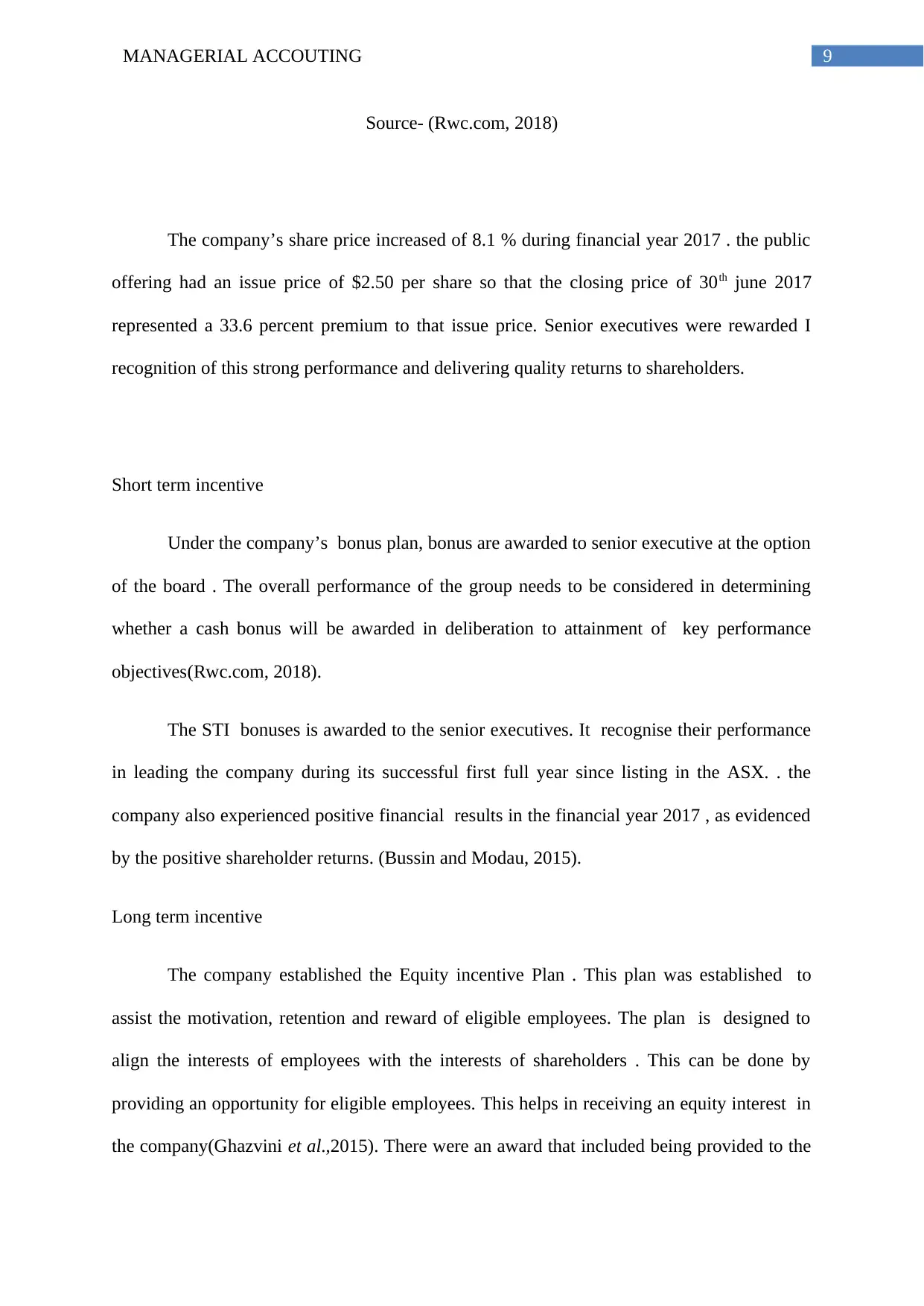
9MANAGERIAL ACCOUTING
Source- (Rwc.com, 2018)
The company’s share price increased of 8.1 % during financial year 2017 . the public
offering had an issue price of $2.50 per share so that the closing price of 30th june 2017
represented a 33.6 percent premium to that issue price. Senior executives were rewarded I
recognition of this strong performance and delivering quality returns to shareholders.
Short term incentive
Under the company’s bonus plan, bonus are awarded to senior executive at the option
of the board . The overall performance of the group needs to be considered in determining
whether a cash bonus will be awarded in deliberation to attainment of key performance
objectives(Rwc.com, 2018).
The STI bonuses is awarded to the senior executives. It recognise their performance
in leading the company during its successful first full year since listing in the ASX. . the
company also experienced positive financial results in the financial year 2017 , as evidenced
by the positive shareholder returns. (Bussin and Modau, 2015).
Long term incentive
The company established the Equity incentive Plan . This plan was established to
assist the motivation, retention and reward of eligible employees. The plan is designed to
align the interests of employees with the interests of shareholders . This can be done by
providing an opportunity for eligible employees. This helps in receiving an equity interest in
the company(Ghazvini et al.,2015). There were an award that included being provided to the
Source- (Rwc.com, 2018)
The company’s share price increased of 8.1 % during financial year 2017 . the public
offering had an issue price of $2.50 per share so that the closing price of 30th june 2017
represented a 33.6 percent premium to that issue price. Senior executives were rewarded I
recognition of this strong performance and delivering quality returns to shareholders.
Short term incentive
Under the company’s bonus plan, bonus are awarded to senior executive at the option
of the board . The overall performance of the group needs to be considered in determining
whether a cash bonus will be awarded in deliberation to attainment of key performance
objectives(Rwc.com, 2018).
The STI bonuses is awarded to the senior executives. It recognise their performance
in leading the company during its successful first full year since listing in the ASX. . the
company also experienced positive financial results in the financial year 2017 , as evidenced
by the positive shareholder returns. (Bussin and Modau, 2015).
Long term incentive
The company established the Equity incentive Plan . This plan was established to
assist the motivation, retention and reward of eligible employees. The plan is designed to
align the interests of employees with the interests of shareholders . This can be done by
providing an opportunity for eligible employees. This helps in receiving an equity interest in
the company(Ghazvini et al.,2015). There were an award that included being provided to the
Paraphrase This Document
Need a fresh take? Get an instant paraphrase of this document with our AI Paraphraser
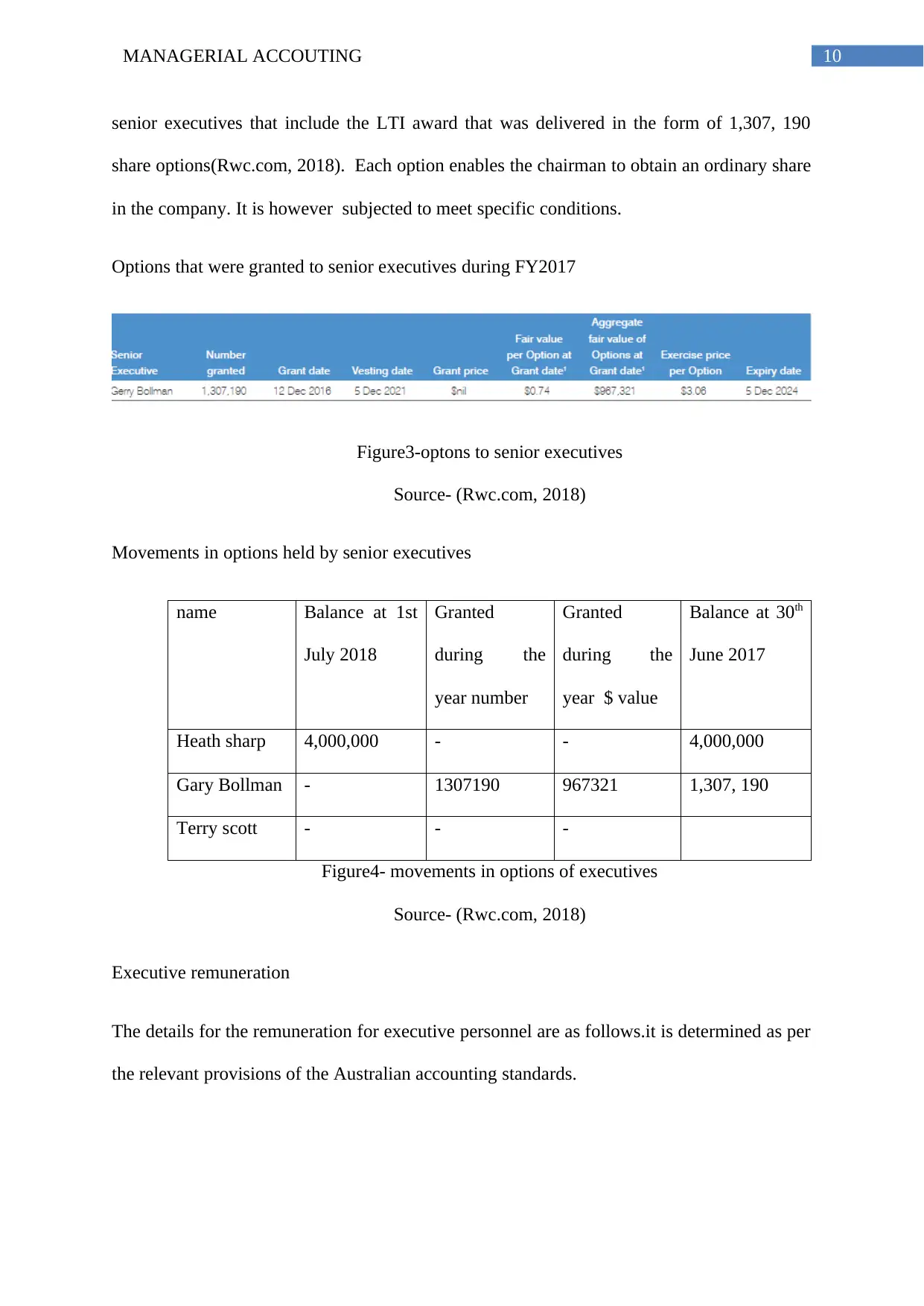
10MANAGERIAL ACCOUTING
senior executives that include the LTI award that was delivered in the form of 1,307, 190
share options(Rwc.com, 2018). Each option enables the chairman to obtain an ordinary share
in the company. It is however subjected to meet specific conditions.
Options that were granted to senior executives during FY2017
Figure3-optons to senior executives
Source- (Rwc.com, 2018)
Movements in options held by senior executives
name Balance at 1st
July 2018
Granted
during the
year number
Granted
during the
year $ value
Balance at 30th
June 2017
Heath sharp 4,000,000 - - 4,000,000
Gary Bollman - 1307190 967321 1,307, 190
Terry scott - - -
Figure4- movements in options of executives
Source- (Rwc.com, 2018)
Executive remuneration
The details for the remuneration for executive personnel are as follows.it is determined as per
the relevant provisions of the Australian accounting standards.
senior executives that include the LTI award that was delivered in the form of 1,307, 190
share options(Rwc.com, 2018). Each option enables the chairman to obtain an ordinary share
in the company. It is however subjected to meet specific conditions.
Options that were granted to senior executives during FY2017
Figure3-optons to senior executives
Source- (Rwc.com, 2018)
Movements in options held by senior executives
name Balance at 1st
July 2018
Granted
during the
year number
Granted
during the
year $ value
Balance at 30th
June 2017
Heath sharp 4,000,000 - - 4,000,000
Gary Bollman - 1307190 967321 1,307, 190
Terry scott - - -
Figure4- movements in options of executives
Source- (Rwc.com, 2018)
Executive remuneration
The details for the remuneration for executive personnel are as follows.it is determined as per
the relevant provisions of the Australian accounting standards.
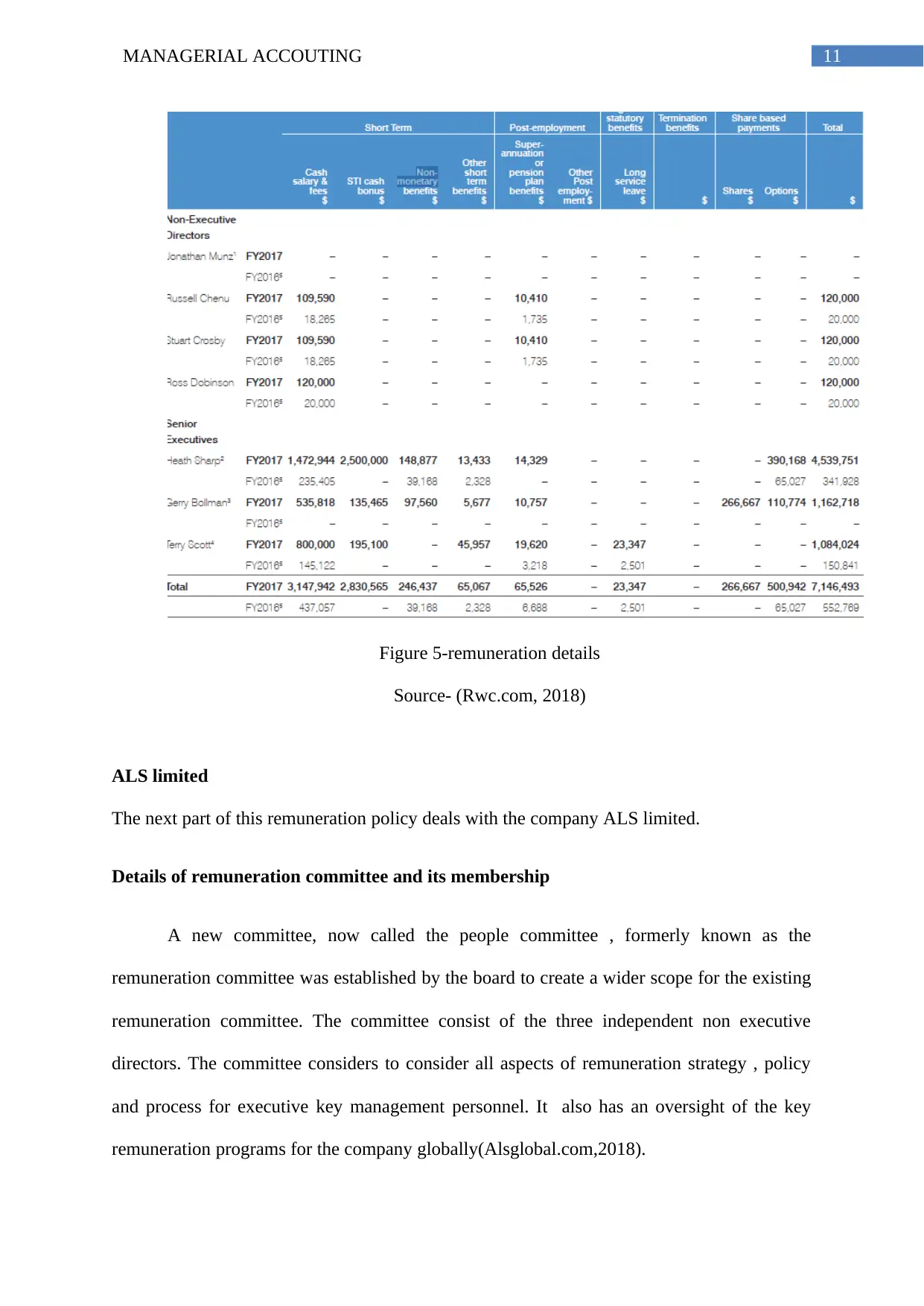
11MANAGERIAL ACCOUTING
Figure 5-remuneration details
Source- (Rwc.com, 2018)
ALS limited
The next part of this remuneration policy deals with the company ALS limited.
Details of remuneration committee and its membership
A new committee, now called the people committee , formerly known as the
remuneration committee was established by the board to create a wider scope for the existing
remuneration committee. The committee consist of the three independent non executive
directors. The committee considers to consider all aspects of remuneration strategy , policy
and process for executive key management personnel. It also has an oversight of the key
remuneration programs for the company globally(Alsglobal.com,2018).
Figure 5-remuneration details
Source- (Rwc.com, 2018)
ALS limited
The next part of this remuneration policy deals with the company ALS limited.
Details of remuneration committee and its membership
A new committee, now called the people committee , formerly known as the
remuneration committee was established by the board to create a wider scope for the existing
remuneration committee. The committee consist of the three independent non executive
directors. The committee considers to consider all aspects of remuneration strategy , policy
and process for executive key management personnel. It also has an oversight of the key
remuneration programs for the company globally(Alsglobal.com,2018).
⊘ This is a preview!⊘
Do you want full access?
Subscribe today to unlock all pages.

Trusted by 1+ million students worldwide
1 out of 23
Related Documents
Your All-in-One AI-Powered Toolkit for Academic Success.
+13062052269
info@desklib.com
Available 24*7 on WhatsApp / Email
![[object Object]](/_next/static/media/star-bottom.7253800d.svg)
Unlock your academic potential
Copyright © 2020–2025 A2Z Services. All Rights Reserved. Developed and managed by ZUCOL.




